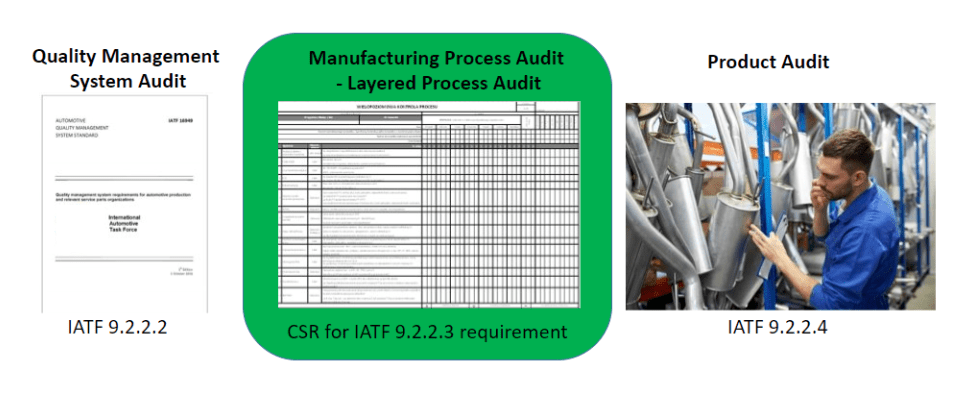Although not explicitly mentioned in the IATF requirements, Layered Process Audit (LPA) is outlined in the Customer Specific Requirements for point 9.2.2.3 related to manufacturing process audits (Stellantis and GM).
However, even if we do not collaborate with the above clients, it is worth considering its implementation in the production plant due to the many benefits it can provide.
LPA – What is it?
LPA takes its name from the requirement that multiple “layers” (i.e., personnel at different levels) of an organization perform the same audit.
Unlike a finished product audit, typically performed by operators or members of the quality team, the Layered Process Audit (LPA) involves designated personnel, spanning from production area leaders to personnel at the highest levels of the plant’s organizational hierarchy. This ensures comprehensive coverage and insights into various aspects of the production process.

Fig. 1. Types of audits in relation to IATF and CSR.
Regarding the scope, LPAs are a qualitative technique focusing on observing and verifying how products are manufactured, rather than on controlling finished products.
They involve not only individuals in quality but also other departments. It is worth noting that they typically encompass corrective and preventive actions implemented during or immediately after the LPA. Although the auditor is not responsible for managing these defined actions.
Most importantly, LPAs aid in gaining control over processes, reducing error rates, and enhancing both work quality and financial outcomes.
Layered Process Audit – Benefits of Use
The Layered Process Audit (LPA) provides numerous tangible and intangible benefits, primarily related to process compliance and its direct influence on product quality. These benefits contribute significantly to overall process improvement and organizational success. The key aspect emphasized here is systematic execution, crucial for achieving the following outcomes:
– Encouraging process standardization
– Strengthening key process steps, often related to special characteristics
– Ensuring safety requirements
– Enhancing interaction between plant management and production operators (detailed in the section:calibration – how to increase competences between individual levels of auditors)
– Empowering operators to provide immediate feedback (on the production line, often referred to as “gemba”) to plant management and implement immediate containment actions (ICA) when necessary
– Unifying process knowledge for operators and all levels of plant management
Implementing LPA yields measurable benefits such as reducing process errors and scrap. Additionally, it enhances the First Time Capability (FTC) of compliant products, contributing to overall process efficiency and product quality. These improvements contribute to a crucial KPI: cost reduction.
It’s essential not to limit verification solely to qualitative aspects. Other areas validated through LPAs include:
– Safety: Ensuring employees possess appropriate skills and permissions, such as wearing required protective gear like glasses, ESD clothing, gloves, etc.
– Maintenance for TPM Level 1: Monitoring and maintenance activities performed by production employees.
Correct LPA implementation and systematic execution enhance product quality, positively impacting customer satisfaction (9.1.2.1 IATF).
You can download an automatic, editable Excel form for free on the Free Quality Tools
Document name: Layered Process Audit – Excel form
Dariusz Kowalczyk


